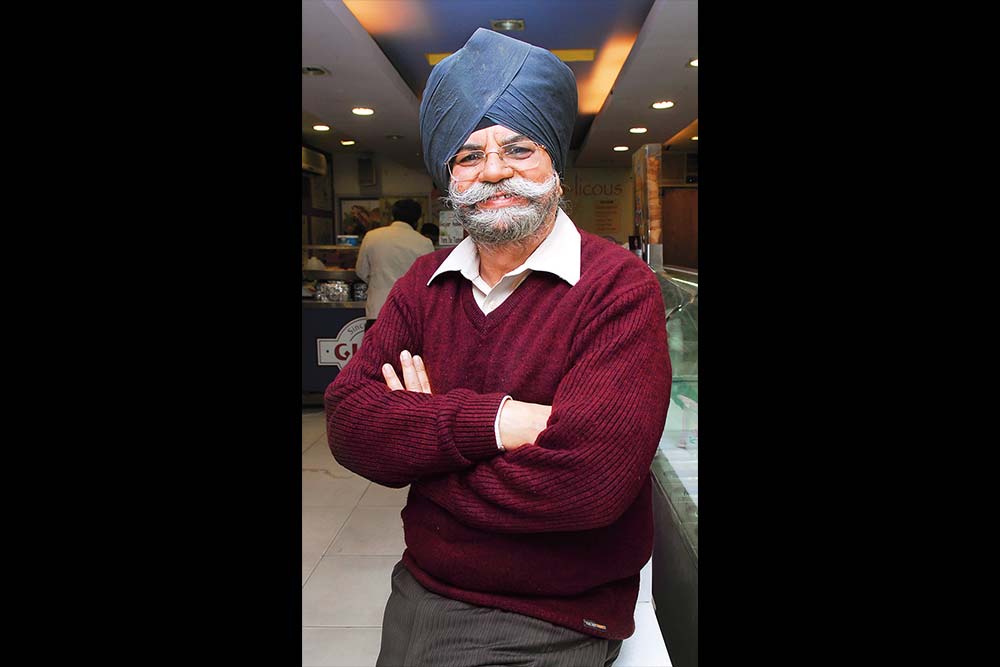Gurbachan Singh could be mistaken for an employee. The humble owner of Giani Ice Cream doesn’t mind a place behind a counter, topping up cones with delicious scoops of ice cream from 35 yummy flavours for loyal Delhiites who have made his brand famous over the past five years. And why wouldn’t they? Giani has become a neighbourhood ice cream destination that is synonymous with decent quality and a variety of flavours at affordable prices. Customers loyal to friendly cartwallahs selling locally popular brands such as Kwality, Jai Hind and Gaylord now troop into the 25-odd Giani parlours across Delhi, Haryana and Punjab.
The family name, Giani, which means “the learned” in Punjabi, became well-known when Giani di Hatti (Giani’s shop) started dishing out rabri faluda, gajar ka halwa and ice cream in 1956 in old Chandni Chowk. The little enterprise’s success was a tribute to the business skills of Gurbachan’s father, Giani Gurcharan Singh, and his uncle, Giani Teerath Singh. “They possessed a skill and art and they made ice cream with their hands in the beginning,” says Gurbachan Singh of his family elders. “MPs and ministers would drop by, so did celebrities such as Raj Kapoor and Mohammad Rafi.”
In 1962, Giani bought its first machine — a second-hand one — but still a huge investment at ₹12,000. As the business prospered, Gurbachan was introduced to the family enterprise in 1970 while he was still an undergraduate. In the same year, the business was divided into two entities — Gurcharan Sons and Giani Ice Cream. Gurbachan and his father took over the now hugely popular Giani Ice Cream.
Cold Facts
Flash forward to 2005 when Giani’s manufacturing facility was shut down in a sealing drive by the authorities since it was operating out of the Rajouri Garden residential area in west Delhi. Gurbachan then set up a new factory in Manesar, Haryana, at a cost of ₹30 lakh. Machinery was imported from the US and Italy to churn creamy ice cream out of 300 litres of milk and 100 kg of sugar a day. Currently the factory is operating at 50% capacity (1,500-1,800 litres per day) in the peak season, but Taranjeet Singh, Gurbachan’s son, plans to double capacity in two years, given sufficient demand.
Currently, apart from parlours in Netaji Subhash Place, Model Town and Punjabi Bagh, Giani has expanded via the franchisee route since 2008, growing to 20 franchisee-run parlours in Delhi, Gurgaon, Faridabad, Ludhiana, Amritsar and Chandigarh. As production capacity can be increased without higher investment, the Singhs are planning on growing regionally with more outlets in the neighbouring states, which is bound to improve margins and profits.
As of now, ice cream is supplied once in 15 days. The cost of a single refrigerated truck trip to, say, Amritsar and Ludhiana from Manesar is about ₹5,000-6,000, borne equally by the franchisee stores in the two cities. Jaipur, less than 200 km from Manesar on the same highway, is also easily serviceable. Gurcharan Singh, meanwhile, does not see Mother Dairy, Amul and Kwality Walls as his competitors. “They sell ice creams in a packed form,” he says. “We sell ours in parlours.” Giani also adds gajar and dal halwas to its menu in the lean (winter) season.
The senior Singh has an interesting array of syrup jars on the table, each labelled more exotically than the other — musk melon, lemon green tea, blackberry. “Till a few years ago, no one had heard of blackberry or blueberry,” says Gurbachan. “Ice creams were all about vanilla, strawberry and tutti-frutti.” Not any more. The Giani Special, Belgian Chocolate and Hot Chocolate Fudge are among the chain’s bestsellers. “We add at least one flavour a month,” says Taranjeet Singh, who did a course on frozen desserts in Italy and is the moving force behind Giani’s tasty experiments. Gelatos were introduced three years ago and there is also a sugar-free variant for diabetics.
Freeze zone
“Their product range and pricing is very smartly done,” says Harminder Sahni, founder and MD, Wazir Advisors, a Gurgaon-based management consulting firm. “The ice cream has been kept affordable and cost much less than it would in a restaurant. Moreover, the focus is entirely on ice cream. If you go to Nirula’s, ice cream is not the only thing they serve.”
If the widespread trend of eating out has favoured the hotels and restaurants business, Giani has something else working for it. “Earlier, people used to have ice cream very occasionally,” says Gurbachan Singh. “Now, they have become more regular.”
Not surprisingly, the turnover shot up from ₹30 lakh in 2006 to ₹1.25 crore in 2011. Profits are in the range of 15% to 20% of sales but, margins are thinning with increasing costs. “In the last two decades the prices were raised only once in three or four years,” says Gurbachan Singh, who admits they are now forced to raise prices every year — the last upward revision came six months ago. The Singhs try to keep labour costs low and manage with about 30 employees at their factory and three owned outlets. Gurbachan Singh is not a big fan of malls either: “People go there mostly to do window shopping, and rentals for shops are very high, too.” Only four of Giani’s 20 franchisee-run outlets are located in malls.
Have there been PE offers? “Investors have approached us but we don’t want to sell for now,” says Gurbachan Singh, who says he feels emotionally attached to the business founded by his father. “It can affect the quality of products.” Moreover, “PE is not the answer to every small business,” Wazir’s Sahni says. “Not everyone can get it and not everyone can handle it.”
However, Giani’s certainly needs to learn a thing or two about upgrading the ambience of its parlours to woo customers. “The management’s attitude has to change from ‘transactional’ to ‘professional’, which reflects in all such things,” Sahni says.
The Singhs, though, have some audacious plans. “We want to be the number one ice cream in India,” says Taranjeet Singh. “We are looking at UP and just opened a store in Rajasthan. We will think about the south only after we have covered the north.” To get there, his strategy is as simple as it has been successful, “We stick to quality and we try to provide fresh ice cream at a reasonable price.”












 Just one email a week
Just one email a week